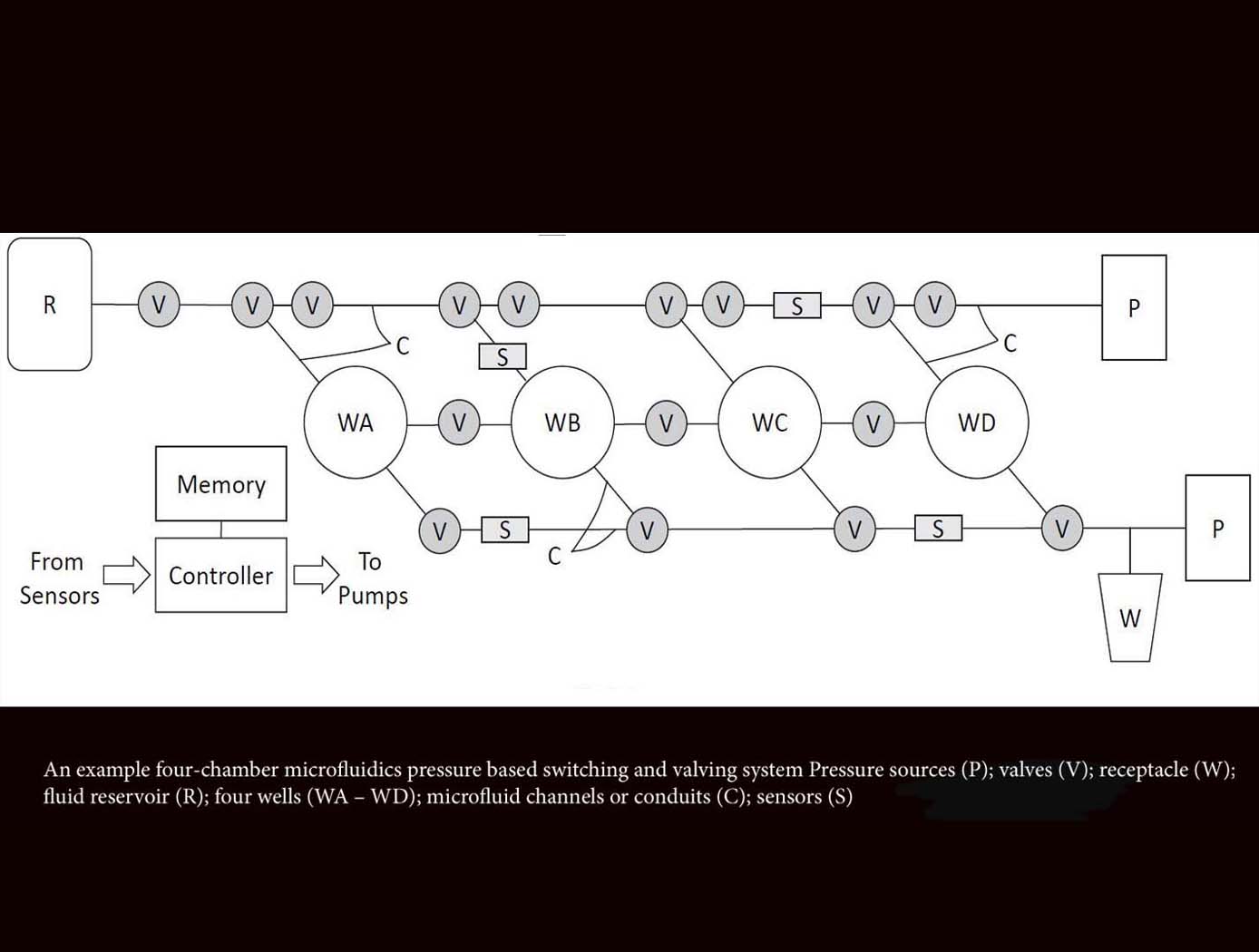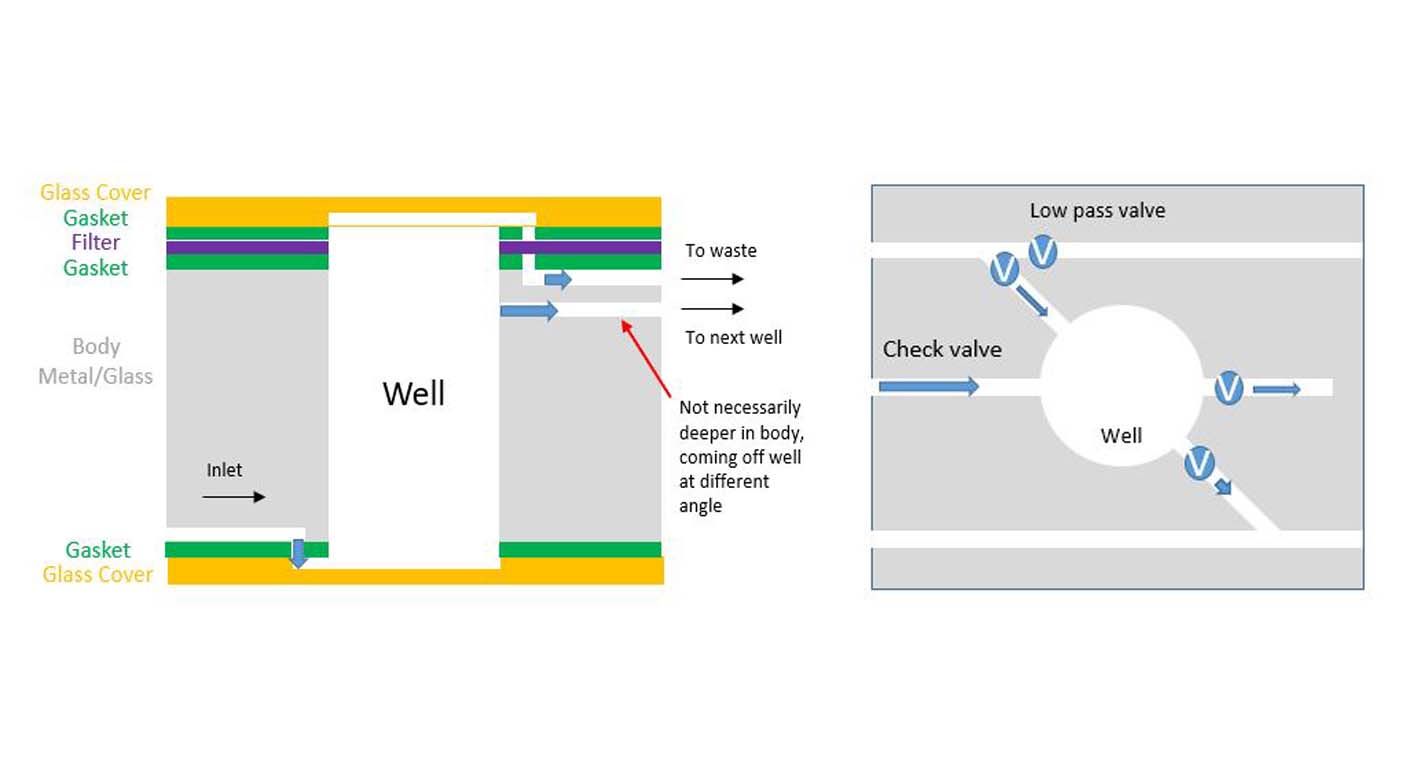Microfluidics Pressure-Based Switching and Valving Array
Mechanical and Fluid Systems
Microfluidics Pressure-Based Switching and Valving Array (TOP2-309)
Automation and miniaturization of complex microfluidics laboratory techniques on a single chip
Overview
Traditionally, laboratory operations in fields such as molecular biology and organic chemistry have required “humans in the loop,” a major inefficiency source and bottleneck for automation. Many lab-on-a-chip devices are designed to perform specific tasks, and do not offer programmable movement of microfluidic-well contents or application-specific reconfigurability. NASA Ames’ researchers have developed a novel method that acts as a microfluidic switch array, determining flow paths using specific logic states achieved through the application of different combinations of pressure and flow conditions to specified valves. This technology facilitates automation of complex laboratory techniques by enabling the programming of any number of sequences by which the contents of microfluidic wells are automatically transferred to specified neighboring chambers, in ways not possible with earlier NASA automated microfluidics technologies.
The Technology
The innovative technology from Ames acts as a microfluidics switch array, using combinations of pressure and flow conditions to achieve specific logic states that determine the sequences of sample movement between microfluidic wells. This advancement will enable automation of complex laboratory techniques not possible with earlier microfluidics technologies that are designed to follow predetermined flow paths and well targets. This novel method also enables autonomous operations including changing the flow paths and targeting well configurations in situ based on measured data decision parameters. This microfluidic system can be reconfigured for use in various experimental applications, requiring only an adjustment of the programmed pressure sequencing, reducing the need for custom design and development for each new application. For example, this technology could provide the ability to selectively constrain or move biological specimens in the experimental wells, allowing evolutionary studies of model organisms in response to various stressors, evaluation of different growth conditions on biological production of antibodies or other small molecule therapeutics, among other potential applications. Likewise, this platform can be used to foster time-dependent, step-wise, chemical reactions, which could be used for novel chemical processes or in situ resource utilization.


Benefits
- Automation of multi-step microfluidics protocols: sequential movement of well contents enables automation of complex laboratory techniques on a single chip
- The movement of well contents can be implemented, and, later changed, through simple programming, so the end user can automate any number of protocols on a single chip
- Miniaturization: small form factor is achieved by reducing the number of large solenoid valves necessary in multi-step microfluidics systems
- The design supports a variety of generational biological experiment possibilities
- The microfluidic card design uses pressure-based actuation of an addressable array of sealing features to transfer samples from one well to another in a stepwise fashion
Applications
- Biotechnology industry
- Chemistry and Life Sciences industries
- Automating laboratory operations such as genomic analysis, drug screening/discovery, high-throughput cellular analysis, automated sample processing, and next-generation sequencing
- Chemical mixing industry
- Radiation exposure industry
- Photochemistry and photobiology industry
- Space and ground sequential biology and/or chemistry experiments not possible with current microfluidic cards
Technology Details
Mechanical and Fluid Systems
TOP2-309
ARC-18428-1
|
Tags:
|
Similar Results

Biomarker Sensor Arrays for Microfluidics Applications
This invention provides a method and system for fabricating a biomarker sensor array by dispensing one or more entities using a precisely positioned, electrically biased nanoprobe immersed in a buffered fluid over a transparent substrate. Fine patterning of the substrate can be achieved by positioning and selectively biasing the probe in a particular region, changing the pH in a sharp, localized volume of fluid less than 100 nm in diameter, resulting in a selective processing of that region. One example of the implementation of this technique is related to Dip-Pen Nanolithography (DPN), where an Atomic Force Microscope probe can be used as a pen to write protein and DNA Aptamer inks on a transparent substrate functionalized with silane-based self-assembled monolayers. But it would be recognized that the invention has a much broader range of applicability. For example, the invention can be applied to formation of patterns using biological materials, chemical materials, metals, polymers, semiconductors, small molecules, organic and inorganic thins films, or any combination of these.

Micro-Organ Device Mimics Organ Structures for Lab Testing
The MOD platform technology represents a small, lightweight, and reproducible in vitro drug screening model that could inexpensively mimic different mammalian tissues for a multitude of applications. The technology is automated and imposes minimal demands for resources (power, analytes, and fluids). The MOD technology uses titanium isopropoxide to bond a microscale support to a substrate and uses biopatterning and 3D tissue bioprinting on a microfluidic microchip to eliminate variations in local seeding density while minimizing selection pressure. With the MOD, pharmaceutical companies can test more candidates and concentrate on those with more promise therefore, reducing R&D overall cost.
This innovation overcomes major disadvantages of conventional in vitro and in vivo experimentation for purposes of investigating effects of medicines, toxins, and possibly other foreign substances. For example, the MOD platform technology could host life-like miniature assemblies of human cells and the effects observed in tests performed could potentially be extrapolated more readily to humans than could effects observed in conventional in vivo cell cultures, making it possible to reduce or eliminate experimentation on animals.
The automated NASA developed technology with minimal footprint and power requirements, micro-volumes of fluids and waste, high throughput and parallel analyses on the same chip, could advance the research and development for new drugs and materials.

Self-Contained Device Isolates Biological Samples
JSC's technology provides hazard-free, microgravity-compatible hardware for DNA/RNA isolation. It also allows PCR analysis to be used outside the lab in environments where pipetting is difficult and/or where hazardous chemicals must be confined to an enclosed container, such as military settings and remote clinical operations.
This self-contained device for isolating DNA/RNA, proteins, and cells is a component system that includes syringes and pistons, membranes of different capacities, reagents, four-way valves, and small pumps. The pre-filled reagents are the same as those used in conventional PCR laboratory isolation analysis. The DNA and RNA isolation kits are novel and process small sample amounts using a self-enclosed and pipette-free technique. Multiple kits can be stacked to allow several samples to be processed simultaneously. The system can be used in conjunction with existing analysis modules, such as commercially available DNA instruments. The process can be fully automated and programmed and can potentially be applied to other biological processes. The JSC innovation will permit the extension of laboratory isolation protocols to many applications.
This NASA Technology is available for your company to license and develop into a commercial product. NASA does not manufacture products for commercial sale.

Nanosensor Array for Medical Diagnoses
Many diseases are accompanied by characteristic odors. Their recognition can provide diagnostic clues, guide the laboratory evaluation, and affect the choice of immediate therapy. The study of the chemical composition of human breath using gas chromatography mass spectrometry (GC/MS) has shown a correlation between the volatile compounds and the occurrence of certain illnesses. The presence of those specific compounds can provide an indication of physiological malfunction and support the diagnosis of diseases. This condition requires an analytical tool with very high sensitivity for its measurement. A number of volatile compounds, so called biomarkers, are found in breath samples, normally at low parts per billion (ppb) levels. For example, the acetone in the exhaled breath from human with other biomarkers can indicate Type I diabetes. Usually, the concentration of the volatile compounds in human breath is very low and the background relative humidity is high, almost 100%. NASAs invention utilizes an array of chemical sensors combined with humidity, temperature, and pressure for real-time breath measurement to correlate the chemical information in the breath with the state and functioning of different human organs. This tool provides a non-invasive method for fast and accurate diagnosis at the medical point of care or at home. The sensor chip includes multisensors for a comprehensive measurement of chemical composition, temperature, humidity, and pressure/flow rate. The sensor data collected from this chip can be wired or wirelessly transmitted to a computer terminal at the doctors desk or hospital monitoring center. The sensor chip can be connected directly or via Universal serial bus (USB) to a cell phone for data transmission over a long distance and receive an instruction from a doctors office for an immediate therapy.

Extractor for Chemical Analysis of Lipid Biomarkers in Regolith (ExCALiBR)
The technology provides miniaturized techniques for extracting trace amounts of organic molecules (lipids) from natural samples. It operates as an autonomous, miniaturized fluidic system, integrating lab techniques for lipid analysis while minimizing reagent volumes and concentrating organics for analysis, thereby increasing signal-to-noise ratios by orders of magnitude. The non-aqueous fluidic system described herein for astrobiological and life-detection missions (either in situ or returned sample) is configured to extract lipid organics from regolith using (1) a fluidic sample processor made of materials compatible with organic solvents and (2) a machine-learning system to select processing steps and parameters to maximize lipid yield. A critical gap is bridged by integrating technologies into a system that replicates analytical lab procedures autonomously on a spaceflight instrument scale with fidelity to original lab techniques. Automated fluidic devices combine controlled handling of liquids with sequential operations and parallelization of replicate processes. By designing such systems to closely interface with both sample-delivery and analytical measurement systems, laboratory analyses are automated. The technology adapts best practice laboratory methods for lipid analysis, overcoming analytical challenges like low organic abundance, interference of minerals/salts, and degradation of origin-diagnostic molecular structures. The extraction and concentration techniques from rock/soil samples can be applied to any biomarkers by changing the solvent, temperature, and agitation.



